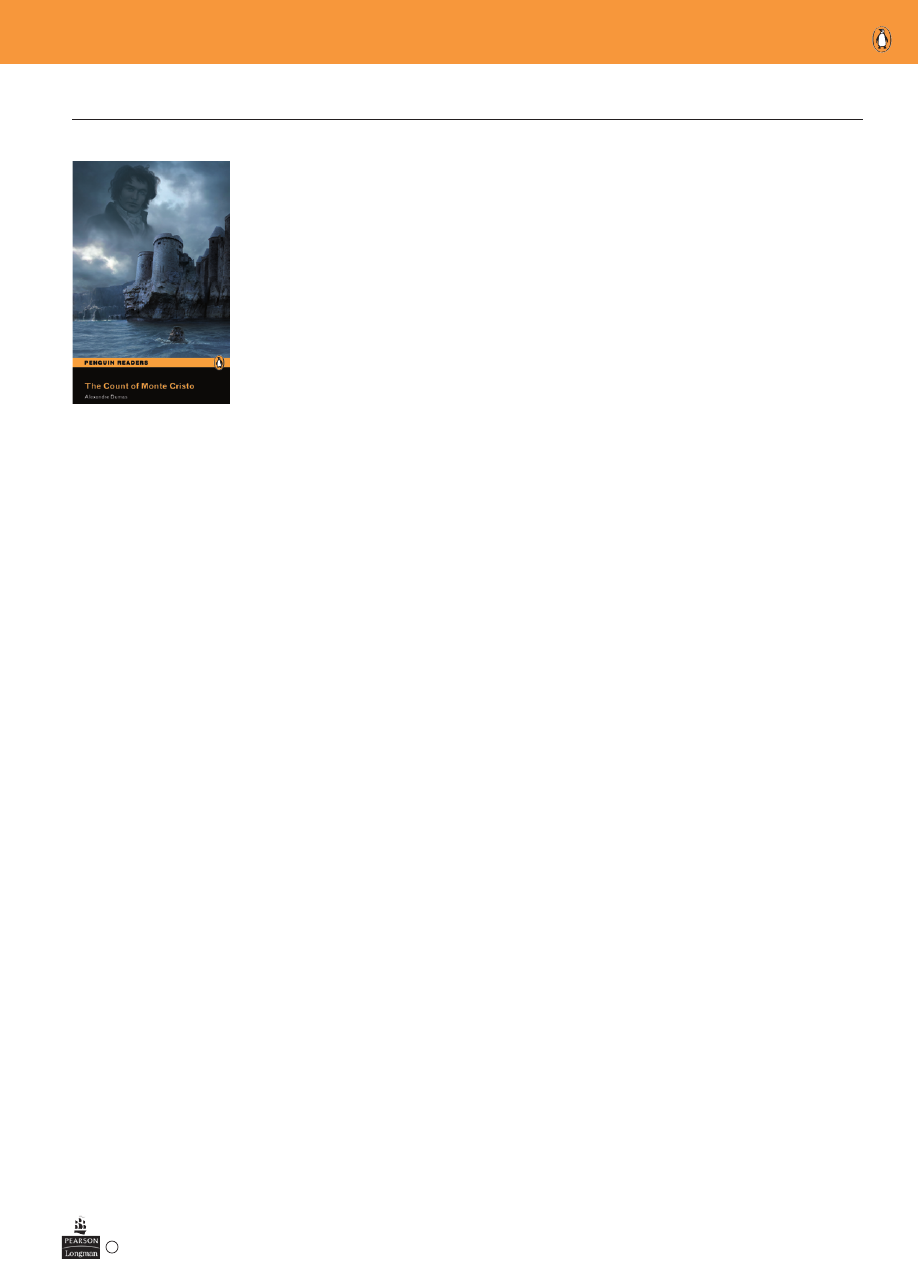
The Count of Monte Cristo
c Pearson Education Limited 2008
The Count of Monte Cristo - Teacher’s notes of 3
Teacher’s notes
LEVEL 3
PENGUIN READERS
Teacher Support Programme
About the author
Alexandre Dumas (1802–1870) is probably the most
widely read of all French writers, best known for The Three
Musketeers and for this story, The Count of Monte Cristo,
a close second. These two world famous books were both
written in the same year, 1844, and translated into English
two years later.
As a child Dumas loved adventure stories and this love
came through later in his own writing. He first became
famous in literary circles with his play Henry III and His
Court, which was first performed in 1829. He went on
to write over 1200 books, although many of these were
the result of his writing factory, where writing apprentices
worked to flesh out his ideas. Nevertheless, nearly all are
clearly the result of his imagination and sense of storyline.
Dumas made a huge amount of money during his life but
spent it all, on a country estate which he called Monte
Cristo, on mistresses and on less successful businesses than
writing.
Summary
Edmond Dantes is on the verge of adult life. He has just
been made captain of a ship and is about to marry his
beautiful fiancée, Mercedes. But he has enemies who envy
him. And he has been foolish. At the dying request of the
previous captain of his ship, the Pharaoh, he has carried a
letter to the exiled Napoleon who has in turn given him a
letter addressed to someone in Paris.
Edmond’s enemies denounce him to the local judge,
Villefort, who recognises the name on the letter as his
father’s and is terrified that he will be linked with plots
against the monarch. He sends Edmond to the Chateau
d’lf, a prison where men go and never return.
After some time he makes contact with another prisoner,
Faria, who has made a secret pathway under the prison.
They meet regularly. Faria teaches Edmond about many
things, and tells him about the Spada treasure on the
island of Monte Cristo.
Faria dies and Edmond sees his chance. He changes places
with the dead Faria, is thrown into the sea and rescued by
a smuggling ship. He finally makes it to Monte Cristo and
finds the treasure.
He returns to Marseilles a rich man, to find Mercedes at
the home of his dying father. The novel ends happily, with
Edmond and Mercedes sailing out of the harbour on his
new boat.
Chapters 1–3: It is 1815. First Officer Edmond Dantes
brings the Pharaoh back to the port of Marseilles. The
captain of the ship, Leclerc, has died on board. Obeying
Leclerc’s last order, Edmond has stopped at the island
of Elba, where Napoleon is, and brought a letter that
he must take to Paris. Morrel, the owner of the ship,
makes Edmond captain and gives him a month to marry
Mercedes, his beautiful fiancée, and go to Paris. Danglars,
a fellow seaman, and Caderousse, Edmond’s neighbour,
are jealous of Edmond’s success. So Danglars makes a plan.
He writes a letter to Judge Villefort saying that Edmond is
working for Napoleon’s cause. On the day of his wedding,
Edmond is taken by soldiers to see Villefort.
Chapters 4–6: Villefort soon finds that Edmond was
only foolishly loyal to his captain and decides to let him
go. But just as Edmond is about to leave, the judge sees
that the letter is addressed to Noirtier, his own father.
Terrified, Villefort burns the letter and promises Edmond
to set him free later but has him taken to the Chateau d’If,
a prison on an island near the port of Marseilles. Stunned,
Edmond insists on seeing the governor, and is soon taken
to the dark cells underground. Some time later, a visit of
the chief officer of prisons brings Edmond some hope. But
the prison book says that Edmond is a dangerous follower
of Napoleon and the officer orders that nothing to be
done about him.
Chapters 7–9: Weeks pass. One evening Edmond hears
noises behind the wall of his cell and tries to make a hole
in the wall. On the other side is Faria, a prisoner who
is trying to dig his way out of the prison. Faria is a wise
man and becomes Edmond’s mentor. Edmond learns a lot
from him. But Faria is ill and knows he will die. He tells
Edmond about a treasure hidden on the island of Monte
Cristo. It is the treasure of the Spada family, which has
been hidden there since Cesare Borgia tried to seize it. The
Alexandre Dumas

The Count of Monte Cristo
c Pearson Education Limited 2008
The Count of Monte Cristo - Teacher’s notes 2 of 3
Teacher’s notes
LEVEL 3
PENGUIN READERS
Teacher Support Programme
directions to get to it have come down to Faria through
his friend, Prince Spada, who never found them hidden
inside a family prayer book. After Spada’s death, Faria had
accidentally found the paper and set it on fire, but had
been able to reconstruct the text. This had been just when
Faria had had to abandon Italy due to the dream he shared
with Napoleon and for which he was put in prison – the
dream of making Italy one country.
Chapters 10–12: Time passes and Edmond keeps
learning from Faria. After some time, Faria gets worse and
dies. Edmond realises that only dead men leave the prison.
He carries Faria’s body to his own bed, covers him with
his bedclothes, and takes Faria’s place in the cloth bag that
will soon be taken away. The guards tie a stone to his feet
and throw him to the sea. Using Faria’s knife Edmond
frees himself from bag and stone. He is later rescued by
the Young Amelia, starts working on board, and sails past
the island of Monte Cristo. After a short stay in Livorno,
the Young Amelia has to sail to Monte Cristo for a meeting
with other smugglers.
Chapters 13–15: After the meeting Edmond explores
the island and pretends to have an accident and be unable
to move. The captain is reluctant to leave him there, but
finally agrees to come for him a week later. Edmond finds
the treasure. He keeps a few gold rings and hides the
treasure again. Back in Livorno, he tells the captain of the
Young Amelia that he has inherited a small fortune, gives
presents to the crew and goes to Genoa. There he buys a
small boat. He sails on his own to the island and hides the
treasure in a secret compartment on the boat. Thence he
heads to Marseilles, where he is welcomed at the Customs
as a rich man. He arrives at his home just before his father
dies, and leaves Marseilles with Mercedes.
Background and themes
Dumas grew up in France at the time of Napoleon’s
rise to pre-eminence in Europe. In the year of Dumas’s
birth, Napoleon was made Consul for life, and eight
years later the French Empire reached its furthest extent.
The soon-to-come massing of enemies, however, led
to his abdication and exile to Elba in 1814. But he was
still popular in France and in 1815 he re-conquered the
country in a matter of days. 100 days later, his final defeat
at the battle of Waterloo led to his permanent exile on the
island of St Helena where he died in 1821.
Society and justice: In this version the novel explores
the idea of human justice, unfair punishment and final
reward. The main characters are clear-cut heroes or villains
and the reader is led to expect fate or divine justice to
redress the unfairness of human society.
Power and powerlessness are also explored in both the
consequences for citizens of political struggle and the
treatment of individuals in line with their fortune.
Discussion activities
Chapters 1–3
Before reading
1 Puzzle: Give students a copy of the following text.
In groups or as homework they solve the puzzle:
In these chapters you are going to meet Danglars, Morrel
and Caderousse.
– One is the owner of the Pharaoh, the ship where
Edmond Dantes is First Officer;
another is the seaman in charge of the goods on the
ship;
the third is Edmond’s father’s neighbour.
– One of the men asks Edmond’s father for money;
another speaks with Edmond about Napoleon;
the third man doesn’t like to take orders from
Edmond.
– We know that the owner of the ship likes Edmond
and makes him captain.
– We also know that the man who asks Edmond’s
father for money doesn’t work on the Pharaoh;
that Danglars and Caderousse tell the government lies
about Edmond.
– We don’t know where Danglars lives.
Students find the answers to these questions:
What do Danglars, Morrel and Caderousse do in these
chapters?
Who is the seaman?
Who is the neighbour?
Who is the owner of the Pharaoh?
If necessary, help students to make a chart (see
Answer key) to help them to work out the answers.
After reading
2 Check: Check students’ answers to activity 1.
3 Discuss: Ask students: How old are Edmond and
Danglars? Do you think age is one of the reasons why
Danglars doesn’t like Edmond? Do people like working
with younger people as their boss? What other reasons
may he have for hating him?
4 Research and artwork: Students use the map on
page viii. They estimate the approximate number of
kilometres that the Pharaoh sailed under Edmond’s
orders. They draw the route on the map and search
the Internet for pictures to make an illustrated version
of it. The maps are displayed on the walls of the
classroom.
5 Role play: Divide the students into groups of
four. They take the roles of Mercedes, Edmond’s
father, Danglars and Caderousse and role play the
conversation they have immediately after the soldiers
take Edmond.

The Count of Monte Cristo
c Pearson Education Limited 2008
The Count of Monte Cristo - Teacher’s notes 3 of 3
Teacher’s notes
LEVEL 3
PENGUIN READERS
Teacher Support Programme
Chapters 4–6
Before reading
6 Write: Tell students: What do you think European
prisons were like in the early nineteenth century? Look
at the cover of the book. Write a paragraph describing
how you imagine the inside of the Chateau d’If and the
prisoners’ lives.
After reading
7 Check and research: Students compare their ideas in
activity 6 to the description in the book. They may
search the Internet for videos or images of the film or
any other picture of the prison.
8 Discuss: Remind students of the following line from
this section ‘On a ship, the last request of an officer is
an order.’ Ask them what the last request of Edmond’s
captain was (to take a secret letter) and remind them
that taking the letter was against the law. Then
divide the students into small groups to discuss this
question: Is it right to break the law if you are obeying
an order?
9 Artwork: Divide the class into four groups. Each
makes a drawing for a four-picture strip cartoon
of this section. They draw Edmond and Villefort,
Edmond on the boat with the soldiers, Edmond in
his room at the Chateau d’If and Edmond with the
chief officer of prisons. They can write a 2-sentence
caption or two bubbles with the characters’ words or
thoughts in each picture. The cartoon must be a brief
synthesis of the section.
10 Write and role play: Ask students: Do you think
Villefort really planned to let Edmond go later that
evening? Students write and role play an episode in
which Villefort decides to send Edmond to the
Chateau d’If. The text may be a monologue or a
dialogue with a character that the students create.
Chapters 7–9
Before reading
11 Guess: Tell students: In this section Edmond needs to
make a sharp tool. What do you think he needs it for?
How he can make it if he only has a bed, a table, a chair
and a water pot?
After reading
12 Discuss: Tell students: Imagine you are Edmond.
What would you like from Faria, his knowledge or his
information about the treasure? Is knowledge more
valuable than money? Why? Does it depend on the
circumstances?
13 Artwork: Students work in pairs. Tell them: Make a
plan of Edmond’s room and write what is around it.
Include the door, the window, the narrow room, the
courtyard, the open pathway, the rock and the governor’s
house. Pairs compare their plans and discuss how they
think Edmond could escape from there.
14 Research: Students search the Internet for the scene
in the film in which Faria gives Edmond the map and
dies (you can alternatively role play the scene in class).
They compare it to the same events in the book and
make notes of the details in the book that aren’t in the
film. Using the information in the book, students
rewrite this segment of the film and act it out.
Chapters 10–12
Before reading
15 Guess: Tell students: These are lines from this section:
‘The old man has gone to look for his treasure.
I hope that he has a good journey!’ (page 27). What
do you think is happening? How do you think what is
happening will help Edmond to escape?
After reading
16 Discuss: Remind students of Edmond’s words
when he sees Faria’s body in a bag – ‘Alone! I am
alone again!’ (page 28) – and have them debate this
question: Why do we cry when somebody that we love
dies? Do we cry for his/her death or do we cry for our
loneliness?
17 Write: Students write the story that Edmond told the
Captain of the Young Amelia about how he lost his
ship in the storm. They vote for the best story.
18 Group work: Students read the last two sections of
Chapter 12 and draw the route of the Young Amelia
on the map they made in activity 4 or on the map on
page viii. Then they discuss whether Edmond’s trips
on the Young Amelia covered more kilometres than his
return from Civitavecchia on the Pharaoh.
19 Artwork: Students look at the pictures in the book
and read page 34, and design a WANTED poster
offering a reward.
Chapters 13–15
Before reading
20 Group work: Students read the headings of the
chapters and predict how the story will end: how
Edmond finds the treasure and takes it out of the
island, how he goes back to Marseilles and what he
does there.
After reading
21 Write: Students write a different version of
Chapter 15, in which all is a dream and Edmond
awakes, still at the Chateau d’If.
Students discuss how the idea of ‘justice’ in the book
becomes different with this different ending.
22 Discuss: Divide the class into two groups and have
them debate the following: Edmond should share his
treasure with the men on the Young Amelia, who saved
his life and took him to the island.
Vocabulary activities
For the Word List and vocabulary activities, go to
www.penguinreaders.com.
Wyszukiwarka
Podobne podstrony:
chocolate upper intermediate teacher's notes
British Life Teachers notes Level 3
Electrocardiograms teacher notes
Kirsty's Secret Teacher's Notes
ho ho ho lesson plan 1 v 2 teacher's notes
ho ho ho lesson plan 1 v 1 teacher's notes
chocolate elementary teacher's notes
ho ho ho lesson plan 2 teacher's notes
cutting edge tests teachers notes
chocolate upper intermediate teacher's notes
British Life Teachers notes Level 3
easter intermediate teacher s notes(2)
family chain teachers notes
crime stories teachers notes
Presidents Day Intermediate Teachers notes
April Fool s PreIntermediate Teacher s notes
Valentines Day Upper Intermediate Teachers notes
Campbell, Joseph The Magic Of Myth Star Wars Teachers Notes
Football Gaffes Answer Key and Teachers Notes
więcej podobnych podstron